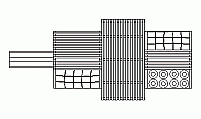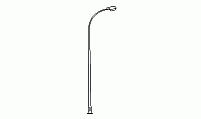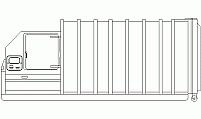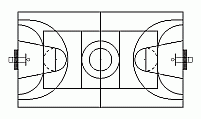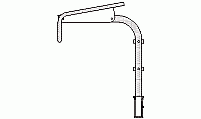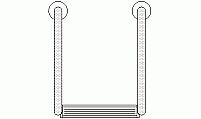CAD Blocks categories
 3D models
3D models home furniture
home furniture sanitary ware - bathrooms
sanitary ware - bathrooms professional equipment
professional equipment doors and windows
doors and windows people and animals
people and animals plants and trees
plants and trees vehicles - transports
vehicles - transports architectural details
architectural details mechanical - electrical
mechanical - electrical urban planning - civil works
urban planning - civil works safety health construction
safety health construction accessible design
accessible design drawing sheet
drawing sheet signals
signals construction machinery
construction machinery accessories and objects
accessories and objects maps and street maps
maps and street maps
Classic Wooden Slat Urban Bench CAD Drawing

size: 5 kb
category: street furniture
related categories:
description: A detailed front view of a classic urban bench made of horizontal wooden slats, supported by a steel frame with two legs for stability.
file extension: .dwg CAD - AutoCAD software
Comprehensive Guide to Urban Bench Designs and Standards
Overview of the Wooden Slat Urban Bench Design
The urban bench in this front elevation CAD drawing features a classic design with horizontal wooden slats forming the seat and backrest. The slats are evenly spaced, creating an ergonomic surface for seating. Supported by two sturdy metal legs, the structure ensures stability and durability. The materials used, typically steel and treated wood, make this bench resistant to outdoor elements. Its simplicity and functionality make it suitable for parks, plazas, and urban environments. This design prioritizes longevity while maintaining a visually appealing aesthetic, fitting seamlessly into various public spaces.
Alternative bench designs include backless options, integrated armrests, or slats made from composite materials. These variations cater to different needs, offering durable and versatile seating solutions for outdoor use. The modular design of slatted benches allows easy maintenance and replacement, enhancing their usability and reducing long-term costs. These designs have become a preferred choice for both aesthetic and functional purposes in public spaces.
Dimensions for Different Sizes of Urban Benches
- What are the dimensions of benches for 2 people?
- Benches designed for 2 people typically have the following dimensions: Length: 48 inches (1.22 meters), Width: 18 inches (0.46 meters), and Seat Height: 16 inches (0.41 meters). These compact benches are ideal for small spaces such as pathways or intimate park areas, ensuring both functionality and comfort.
- What are the dimensions of benches for 3 people?
- Benches accommodating 3 people usually feature these dimensions: Length: 60 inches (1.52 meters), Width: 20 inches (0.51 meters), and Seat Height: 17 inches (0.43 meters). These benches provide ample seating space while maintaining a moderate footprint, making them suitable for most public areas.
- What are the dimensions of benches for 4 people?
- Benches for 4 people are generally larger, with the following dimensions: Length: 72 inches (1.83 meters), Width: 22 inches (0.56 meters), and Seat Height: 17 inches (0.43 meters). These benches are a popular choice for parks and plazas, offering generous seating capacity without compromising accessibility.
- What are the dimensions of benches for 5 people?
- Benches for 5 people typically measure: Length: 84 inches (2.13 meters), Width: 24 inches (0.61 meters), and Seat Height: 18 inches (0.46 meters). These benches are designed for larger public spaces, ensuring durability and comfort for extended use.
- What are the dimensions of benches for 6 people?
- Benches that accommodate 6 people have substantial dimensions: Length: 96 inches (2.44 meters), Width: 26 inches (0.66 meters), and Seat Height: 18 inches (0.46 meters). These large benches are ideal for high-traffic areas or group seating in parks, ensuring stability and spaciousness.
FAQs on Materials and Installation
- What materials are used in this type of bench?
- Wooden slat benches are commonly constructed from treated wood, such as teak or cedar, for the seating area, combined with metal frames made from steel or aluminum. The wood is treated to resist moisture, UV rays, and insects, while the metal components are galvanized or powder-coated to prevent rust and corrosion. These materials ensure durability and weather resistance for long-term outdoor use.
- How are benches like this anchored?
- Benches are typically anchored using bolts and plates secured to concrete pads or similar stable surfaces. Some designs incorporate embedded anchors during installation, providing additional stability. This ensures the bench remains securely in place, preventing tipping or theft. Proper anchoring is essential for both safety and functionality in high-traffic public areas.
- Are wooden slat benches weather-resistant?
- Yes, wooden slat benches are designed to withstand outdoor conditions. The wood is treated with weather-resistant finishes to protect against moisture, sun damage, and wear. Metal frames are coated with anti-corrosion treatments, ensuring long-lasting performance. These measures make the benches suitable for diverse climates and environments.
- Can this design accommodate accessibility needs?
- Yes, benches can be modified to meet accessibility standards such as ADA guidelines. Features like appropriate seat height, armrests, and clear ground space for wheelchair access ensure inclusivity. These adjustments make the bench suitable for use by individuals with varying mobility needs, enhancing its functionality in public spaces.
- What maintenance is required?
- Maintenance for wooden slat benches includes regular cleaning and periodic inspection for wear and tear. Wooden components may require re-sealing or sanding to maintain their protective finish, while metal parts should be checked for rust or loose bolts. Routine upkeep ensures the bench remains safe, durable, and visually appealing over time.
Advantages of Wooden Slat Urban Benches
Wooden slat benches offer a range of benefits for outdoor public spaces. The natural aesthetic of the wood provides a welcoming and attractive seating option. The slat design promotes ventilation, preventing water accumulation and ensuring quick drying after rain. Metal frames add structural strength, ensuring the bench withstands heavy use in busy urban environments. Additionally, the modular nature of slats allows for easy replacement, reducing maintenance costs and enhancing long-term usability.
Compared to other designs, these benches are highly adaptable and can fit a variety of settings. The use of treated wood and corrosion-resistant metal makes them durable and low-maintenance. Eco-friendly options, such as certified sustainable wood or recycled materials, further enhance their value. Their balance of functionality, durability, and aesthetic appeal makes them an ideal choice for urban design projects.
History and Evolution of Wooden Slat Benches
The history of wooden slat benches dates back to the 19th century, when public parks began incorporating them as essential urban furniture. Early designs featured ornate cast iron frames and untreated wooden slats. Over time, advancements in material science and design streamlined their appearance and improved durability. Modern benches now use treated wood and corrosion-resistant metals, offering superior performance in outdoor settings.
Globally, wooden slat benches have adapted to cultural and environmental needs. European designs often include intricate details and artistic elements, while North American benches prioritize simplicity and sustainability. In Asia, natural materials like bamboo are used to integrate with the environment. These benches’ evolution reflects their versatility and enduring relevance in public and private spaces worldwide.











